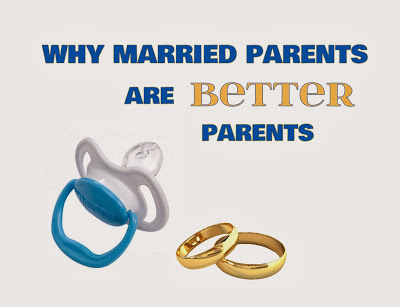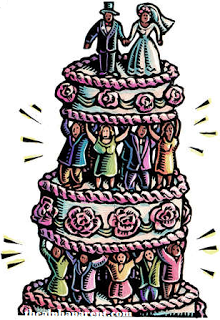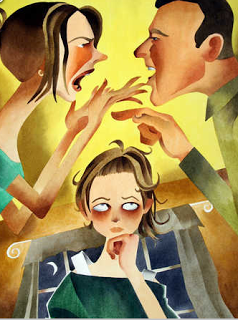
Recently, a topic was posted on The Alpha Parent forum, asking the question: “Do married parents make better parents?” Predictably, a tussle ensued between the pro-marriage lobby and the cohabitors’ club. So, what’s all the fuss about? Marriage is just a piece of paper, right?
Wrong! In this post I’m going to argue why married parents are better parents, dispelling a few myths along the way.
Two caveats before we begin: Firstly, I’m not going to discuss the merits of single parenting vs couple parenting. That topic has been done to death with the overwhelming majority of research showing that two parents are better than one. Secondly, I’m not going to bring religion into this, there’ll be no reference to God. This gives credence to the fact that both religious and non-religious people are partial to marriage.
So, why are people getting their panties firmly lodged up their asscracks and feeling compelled to defend their marital status (or lack of), particularly with regard to childrearing? After all, you would be forgiven for thinking that marriage is an outdated institution, a dying relic of historical but not modern significance. The statistics are certainly pointing in that direction…
MYTH: There’s no point getting married because the divorce rate is so high

FACT: Sure, our divorce rate is climbing, largely due to the diminishing stigma of divorce. However divorce rates, whilst they may fuel Daily Mail sales, are actually a red herring. In reality, parents who are married are more likely to stay together. Although background factors – such as age, income, education, and ethnic group – influence the odds of new parents splitting up, the single biggest factor is whether the parents are married or not. This is partly because the nature of marriage as a social institution brings with it a range of social norms which actually promote behaviours more likely to safeguard the relationship. Another reason is that men and women commit in different ways. Women commit when they move in. Men commit when they make a clear decision about their future (Benson 2010; Kirby 2002).
Harry Benson of Birmingham University analysed data from the Millennium Cohort Study of 15,000 mothers who gave birth during 2000 and 2001. He found that across all income and education groups, unmarried parents with under-fives were at least twice as likely to split up compared to equivalent married parents! Why? Because “cohabiting fathers are less committed and cohabiting mothers are more insecure” (Benson 2010). Other studies back this up: cohabiting parent families are considerably less stable than married parent families. Nearly 30% of children in cohabiting parent families experience a change in family structure between the 9-month and 24-month mark versus fewer than 2% of children in married parent families (Brown 2008). In essence: marriage is still the best and most reliable way of expressing commitment.
MYTH: Marriage is just a word – a piece of paper
FACT: Marriage symbolises Dedication, and dedication is the internal force between the couple that reflects the depth of relationship, their friendship. It’s the extent to which a couple see themselves as a couple rather than two individuals, the extent to which they talk and think in terms of “we” and “us”. The first sure sign of dedication is a strong sense of identity as a couple. The second sure sign of dedication is to have a sense of future together. Marriage fulfils both of these pivotal roles.
MYTH: It doesn’t matter what other people think

FACT: Marriage is a broadcasted message of dedication. It is a clear and unambiguous commitment to a future together. You may be pondering, surely it doesn’t matter what other people think? Why do we need to broadcast our commitment? Well, you might be surprised to learn that a public and legal declaration of your intention to stay together actually increases the stability of your relationship. Getting married represents a clear decision about your attitude and intentions towards one another. Marriage looks at two people from the outside as a couple and makes it harder for them to leave one another – essentially, it creates constraints. Getting married makes it crystal clear to you both and to everybody else – friends, family, other singles, the law, the government – that you are a couple who plan to stay together for life. It encourages these sources to see you as one couple rather than as two individuals.
Before you scowl at the thought of two miserable people staying together because they’re scared that people will judge if they split – think again. When dedication is strong, constraints actually feel positive (Benson 2013).
MYTH: You can still have a permanent future together without getting married.

FACT: Technically yes, and some people achieve this, however the odds are stacked against them. Most cohabitations are short-lived; they typically last for about a year or a little more and then are transformed into marriages or dissolve (Waite 2000). This makes sense when you bear in mind that one of the most common reason that couples give for cohabiting rather than marrying is to “test the relationship”. This is particularly true of men’s reasoning in heterosexual relationships (Huang et al 2011; Jay 2012; Jayson 2005). Cohabiting enables a couple (particularly the man) to test compatibility with their partners, while still having the option of ending the relationship without legal implications. Not believing in marriage is seldom given as a reason for cohabiting (Rhoades et al 2009).
Myth: Having children will strengthen my cohabiting relationship.

FACT: Whilst childbearing and childrearing have been shown to strengthen marriage, the opposite is said for cohabitation. Cohabiting couples can ‘slide’ into parental responsibilities without making a decision about their commitment to each other. These responsibilities create strain on the relationship and a feeling of entrapment: relationships continue which might otherwise have ended earlier but without the mutual commitment that can help in such pressured circumstances. Benson 2013 explains:
“It’s easier for men to go along for the ride without ever really committing to anything more. A man who slides into a living arrangement with his girlfriend may not be quite as committed as she assumes he is. But once they have moved in together, inertia means it is harder for him to back out again. He can ‘slide’ in, but he has to ‘decide’ out. Then she gets pregnant because all seems well. But he finds himself ever more deeply trapped. The prospect of twenty years of unplanned parenthood forces him to run for cover. It was good while it lasted, but he hadn’t signed up for this”.
Cohabitation is a transient condition. In 2006, just 7 per cent of couples who were unmarried when their child was born were still cohabiting by their 16th birthday (Harris 2010). Meanwhile, the intentional commitment of marriage is well known to be a protective factor (Rhoades et al 2006). Within five years of the birth of a child, 52 per cent of cohabitees have split up, compared with with just eight per cent of married couples (Kirby 2002).
MYTH: Getting married is too expensive.

FACT: Not true. It is possible to have a basic wedding for as little as $100. Even if you’re the kind of person that insists on the ‘dream wedding’, the financial rewards of marriage will still trump the initial costs. Cohabitors who never marry have 78 percent less wealth than the continuously married (Schneider 2007). If you cohabit, your partner has no responsibility for your financial support and most cohabiters do not pool financial resources (Waite 2000). This is reinforced legally as in the eyes of the law, each partner in a cohabiting couple is responsible for their own financial situation; and as far as banking is concerned, if one partner in the cohabiting couple dies the surviving partner has no legal right to any monies left by their partner unless specified in a will.
And what about children? The poverty rate among children of cohabiting couples is five times greater than the rate among children in married-couple households (Schneider 2007).
MYTH: Marriage won’t make me any happier than I already am.

MYTH: As long as two parents are committed, the effect on their children of not being married will be minimal.
FACT: The tentative, impermanent, and socially unsupported nature of cohabitation impedes the ability of this type of partnership to deliver the same feeling of security as marriage. Children thrive on the reassurance of security. Their development is impeded when they feel insecure. The uncertainty about the stability and longevity of their parents’ relationship can cause emotional problems for their offspring (more on this below).
MYTH: Whether I’m married or not has no bearing on my behaviour

If you are cohabiting you are more likely to withdraw from conflict and ‘opt out’, meaning that issues never get resolved and resentment builds. Lack of commitment reduces the incentive to invest the time, care and energy needed to resolve arguments. Amongst those who do not back off in this way, cohabiting parents are also more likely than married parents to ‘fire back’ during arguments – behaviour which involves putting down one’s partner or scoring points. These are typical behavioural characteristics of less committed people, their use is normalised because the participants deem there is ‘less to lose’ by behaving dismissively or contemptuously. Lack of commitment seems to reduce the inhibition to treat spouses or partners with care and courtesy in the face of conflict and provocation. “The sheer complexity of the differences found between cohabiting and married couples suggests that the nature of marriage and cohabitation influences how couples interact” (Benson 2007).
MYTH: My partner’s family would not treat me any differently if we were married.
FACT: In cohabiting families, children often find themselves without grandparents, aunts, uncles, and cousins; the family tree is pruned (Booth et al 2013). The temporary and informal nature of cohabitation makes it more difficult and riskier for extended family to invest in and support the relationship. Parents, siblings and friends of the partners are less likely to get to know a cohabiting partner than a spouse (Waite 2000). Parents of one member of a cohabiting couple are ill-advised to invest in the partner emotionally or financially until they see if the relationship will be long term. They are also ill-advised to become attached to offspring because their “grandparent” relationship with those offspring will dissolve if the cohabitation splits up. This is particularly the case for paternal grandparents and is no doubt bolstered by the fact that a cohabiting father has no legal rights unless registered on a birth certificate.
MYTH: My child’s happiness isn’t predicted by whether I cohabit or marry.

FACT: 15.7 percent of 6- to 11-year-olds in cohabiting families experience serious emotional problems (e.g., depression, feelings of inferiority, etc.), compared to just 3.5 percent of children in families headed by married parents (Acs and Nelson 2002). For 12-17 year olds, those with cohabiting parents are six times more likely to exhibit emotional and behavioral problems (Booth et al 2013; Cavanagh 2008).
MYTH: Cohabiting won’t impact upon my child’s educational achievements.
FACT: Studies have shown a decrease in math skills and an increase in delinquency among children of cohabiting couples (Dunifon and Kowaleski-Jones 2002; Nelson et al 2001). Perhaps even more shocking is the fact that children of cohabiting parents have worse mental development than children from single parent families! (Booth et al 2013; Brown 2008; Artis 2007). Adolescents from cohabiting households are 122 percent more likely to be expelled from school and 90 percent more likely to have a low Grade Point Average (Manning and Lamb 2004).
MYTH: Cohabiting does not place my child or myself in a greater risk of danger.

FACT: The UK broadsheet newspaper The Telegraph has reported that:
“The picture is bleak from babyhood onwards.
Infant mortality is substantially higher for children of cohabiting parents than for those of married parents, babies born outside marriage are more likely to have low birth weights, to suffer childhood accidents, and to be at much higher risk of child abuse” (Kirby 2002).
It is a distressing fact that cohabiting relationships are significantly more likely to turn violent than marriages (Kenney and Mclanahan 2006). The Family Violence Research Program at the University of New Hampshire, the nation’s leading institution studying domestic violence, discovered some shocking statistics: the overall rate of violence for cohabiting couples is twice as high as for married couples and the overall rate for “severe” violence is nearly five times as high. This holds true, even when controlling for factors as education, age, occupation and income (Tyree 2010).
You may be wondering whether the higher rates of domestic violence in cohabiting relationships are simply because women in married relationships are less likely to report violent acts committed against them. Yet, these studies control for such factors and still show significantly higher levels of violence among cohabitors. When we look at cases of direct violence against children, the picture gets even more horrific:
“Children who live in homes with cohabiting parents are more likely to: become involved in premarital sexual activity, experience sexual abuse in the home, have emotional and social difficulties, and have difficulty forming permanent emotional attachments when they reach adulthood, including having happy and productive marriages” (First Things First 2013; see also OPRE 2011).
We can really see things in perspective when we look at how other family types measure up: Rates of serious child abuse are lowest in married families; six times higher in stepfamilies; 14 times higher in always-single-mother families; and 20 times higher in cohabiting biological-parent families (Booth et al 2013). In other words, a child is less safe when she is living in a home with her parents if her parents’ relationship does not enjoy the legal, social, and moral status and guidance that marriage confers on relationships.
MYTH: It’s none of your business whether I’m married or not.

Add to this, the fact that cohabitation raises crime rates: three-fourths of children involved in criminal activity were from cohabiting households (Booth et al 2013). Surely not living in a crime-ridden society is everyone’s prerogative? Not to mention the undeniable fact that the welfare of children is everyone’s business. Yup, even children to whom we are not blood related.
To sum it all up: Marriage fosters certain behavioral changes – by both the couple and those around them – that cohabitation simply doesn’t encourage. Cohabitation is a tentative, non-legal coresidential union. It does not require or imply a lifetime commitment to stay together. Married couples link their fates – including their finances. Marriage is, by design and agreement, for the long run – the ideal environment for child-rearing, whatever your age, sexual orientation or religion.










